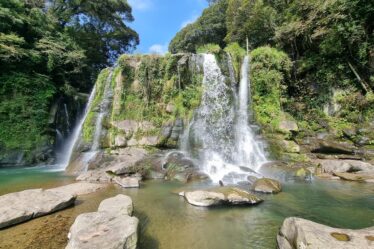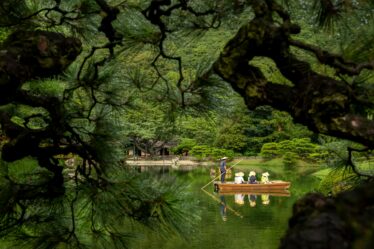

Most hotels served breakfast between 6.30 am to 9 am.







And most had quite a good spread.

Just take enough for yourself. Do not waste food.

We started the morning with Nobeoka Castle ruins.





Perched atop a hill overlooking the city, these ancient ruins once served as the seat of power for the Naito clan during the Edo period. While the castle itself no longer stands, visitors can explore the remnants of its stone walls, moats, and defensive structures, which bear witness to centuries of military prowess and strategic planning.





Our next destination was Atagoyama Lookout.
Situated atop Mount Atago, this scenic viewpoint provides a captivating vantage point from which to admire the sprawling urban area, the majestic outline of Mount Aso in the distance, and the picturesque Kuma River winding through the valley below. Accessible by car or foot, Atagoyama Lookout is a popular destination for locals and tourists alike, especially during sunset or in the evening when the city lights illuminate the skyline, creating a magical ambiance.

Heiwadai Park was not on our list to visit but saw the sign board and went ahead.

Follow the instructions and you will hear the ringing sound. Which we did.

Miyazaki Jingu was our next destination but the main shrine was still under re-construction.





The shrine is a revered Shinto shrine dedicated to Emperor Jimmu, the legendary first emperor of Japan. Established over a thousand years ago, Miyazaki Jingu is steeped in history and cultural significance, making it one of the most important shrines in the region.
The shrine’s majestic entrance gate, or torii, welcomes visitors into a sacred space surrounded by lush greenery and towering cedar trees. As visitors approach the main hall, they pass through a series of beautifully landscaped gardens, stone lanterns, and decorative fences, creating a serene and tranquil atmosphere conducive to prayer and contemplation.
At the heart of Miyazaki Jingu lies the honden, or main hall, where worshippers come to pay their respects, offer prayers, and seek blessings for health, prosperity, and success. Surrounding the main hall are several auxiliary shrines, dedicated to various Shinto deities and spirits, each with its own unique rituals and traditions.

Along the way, we saw many roadside stores run by the farmers. Do stop by to take a look. It turns out to be quite interesting.

Obi Castle Ruins was next.




While the castle itself no longer stands, visitors to Obi Castle Ruins can explore the remnants of its stone walls, moats, and defensive structures, which bear witness to centuries of military prowess and strategic planning. The site is surrounded by lush greenery, creating a serene and picturesque setting that invites contemplation and exploration.

As we were behind time, we rucshed over to Udo Jingu.

The nearest car park was a distance away. To get to the shrine, we were required to climb stairs

and walk for about 15 minutes.



Some of the other smaller shrines.

The main Shrine itself was located under the mouth of the cave. The approach to Udo Jingu winds through scenic coastal landscapes, with views of the azure sea and rugged cliffs creating a sense of tranquility and reverence. Visitors pass through a torii gate carved into the cliffs before descending a series of stone steps to reach the main shrine nestled within a cave, known as “Udo-no-Taki” or “Cave of Returning Waves.”

Inside the cave, worshippers and visitors can offer prayers for safe childbirth, maritime safety, and prosperity while gazing out at the mesmerizing view of the ocean waves crashing against the rocks below. The shrine’s serene ambiance and mystical atmosphere make it a popular destination for spiritual reflection and cultural pilgrimage.

Our next destination for today was Sun Messe Nichinan.
This is a unique cultural attraction that pays homage to the ancient civilization of Easter Island, also known as Rapa Nui. This expansive park features replicas of the iconic moai statues, or stone monoliths, that are synonymous with Easter Island’s enigmatic history and cultural heritage.





Visitors to Sun Messe Nichinan can explore the park’s meticulously crafted replicas of moai statues, which are set against the backdrop of lush greenery and panoramic ocean views, reminiscent of the landscapes of Easter Island. The statues, ranging in size and style, offer a captivating glimpse into the artistic and spiritual traditions of the Rapa Nui people.
In addition to the moai statues, Sun Messe Nichinan features an array of cultural exhibits, interactive displays, and educational materials that shed light on the history, art, and mythology of Easter Island. Visitors can learn about the significance of the moai statues, the rituals of the Rapa Nui people, and the mysteries surrounding the island’s ancient civilization.

Our last destination for today was the Aoshima Shrine.
Aoshima Shrine, nestled on Aoshima Island in Miyazaki City, Miyazaki Prefecture, Japan, is a sacred Shinto shrine steeped in mythology and natural beauty. Dedicated to the deity of marriage and good fortune, Aoshima Shrine is renowned for its picturesque setting, surrounded by lush vegetation, rocky cliffs, and the azure waters of the Pacific Ocean.





Visitors to Aoshima Shrine follow a winding path across a red torii gate, which spans a narrow isthmus connecting Aoshima Island to the mainland. As they approach the shrine, visitors are greeted by a serene atmosphere and panoramic views of the surrounding seascape, creating a sense of reverence and tranquility.

The main hall of Aoshima Shrine, adorned with traditional architecture and intricate wood carvings, is a focal point for worshippers and visitors alike. Here, visitors can offer prayers for love, happiness, and prosperity, as well as participate in various rituals and ceremonies that celebrate the shrine’s rich cultural heritage.
In addition to its spiritual significance, Aoshima Shrine is also known for its natural attractions, including the iconic “Devil’s Washboard” rock formation, which stretches along the coastline and is believed to have been sculpted by the tides over millions of years.

Before heading for our hotel, we visited the Aeon Mall in Miyazaki City and had dinner there.

Our room for tonight. Good night…………


